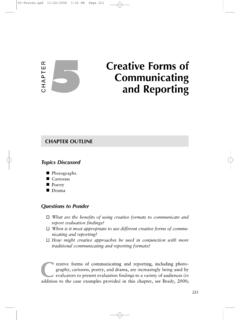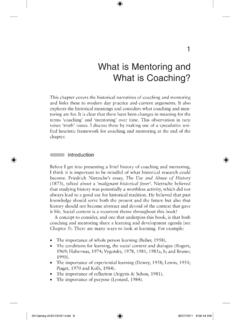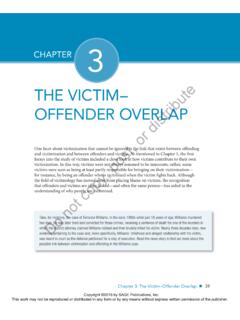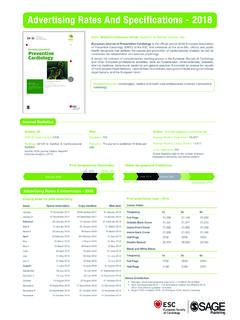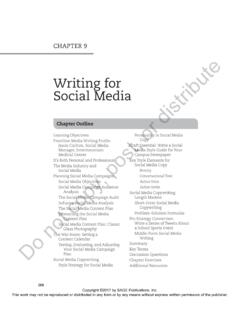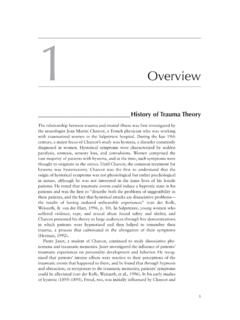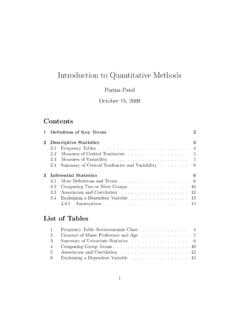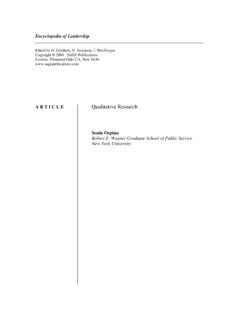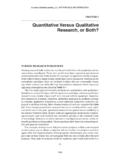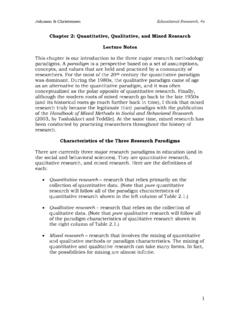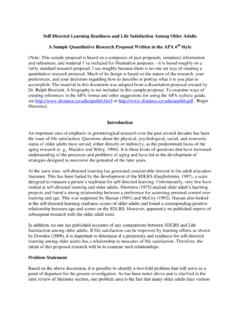Transcription of Quantitative Research Methods - SAGE Publications
1 Quantitative Research MethodsThis chapter focuses on Research designs commonly used when conducting Quantitative Research studies. The general purpose of Quantitative Research is to investigate a particular topic or activity through the measurement of variables in quantifiable terms. Quantitative approaches to conducting educational Research differ in numerous ways from the qualitative Methods we discussed in Chapter 6. You will learn about these characteristics, the Quantitative Research process, and the specifics of several different approaches to conducting Quantitative Learning ObjectivesAfter studying Chapter 7, students will be able to do the following:1.
2 Describe the defining characteristics of Quantitative Research studies2. List and describe the basic steps in conducting Quantitative Research studies3. Identify and differentiate among various approaches to conducting Quantitative Research studies4. List and describe the steps and procedures in conducting survey, correlational, causal-comparative, quasi-experimental, experimental, and single-subject research5. Identify and discuss the strengths and limitations of various approaches to conducting Quantitative research6. Identify and explain possible threats to both internal and external validity7. Design Quantitative Research studies for a topic of interest Copyright 2016 by SAGE Publications , Inc.
3 This work may not be reproduced or distributed in any form or by any means without express written permission of the publisher. Do not copy, post, or distribute108 Part II Designing A Research StudyCharacteristics of Quantitative ResearchQuantitative Research relies on the collection and analysis of numerical data to describe, explain, predict, or control variables and phenomena of interest (Gay, Mills, & Airasian, 2009). One of the underlying tenets of Quantitative Research is a philosophical belief that our world is relatively stable and uniform, such that we can measure and understand it as well as make broad generalizations about it.
4 You should note right away the stark contrast between this belief and those of qualitative Research namely, that the world is ever changing and the role of the researcher is to adapt to and observe those constant changes. Gay and colleagues state that, from a Quantitative perspective, conclusions drawn about our world and its phenomena cannot be considered meaning-ful unless they can be verified through direct observation and measurement. Further, Quantitative researchers typically base their investigations on the belief that facts and feelings can be separated, and that the world exists as a single reality composed of facts that can be discovered through observation or other measurements (Fraenkel, Wallen, & Hyun, 2012).
5 Yet again, this belief operates in stark contrast to the assump-tion held by qualitative researchers that individuals, in essence, are responsible for developing their own separate and unique realities of the same goal of Quantitative Research studies is vastly different from the qualitative goal of gaining a better understanding of a situation or event. When conducting Quantitative Research studies, researchers seek to describe current situations, establish relationships between variables, and sometimes attempt to explain causal relationships between var-iables. This type of Research is truly focused on describing and explaining sometimes in a somewhat definitive manner the phenomenon under investigation (Creswell, 2005).
6 Because of this singular perspective, Quantitative Research operates under widely agreed-on steps that guide the Research process (Fraenkel et al., 2012). The Quantitative Research process along with its various designs is fairly well established; there is lit-tle flexibility in terms of the strategies and techniques used. Quantitative researchers believe that nothing should be left to chance; therefore, no aspect of the Research design is permitted to emerge during the process, as it is in qualitative role undertaken by the Quantitative researcher is very different from that of his or her qualitative counterpart.
7 One of the goals of qualitative Research is for the researcher to become deeply immersed in the setting and among the participants. However, a major goal of Quantitative Research is for the researcher to remain as objective as possible (although, as we have previously discussed, all researchers have biases and it is more important that they recognize those biases and discuss their limitations). The much more linear steps in the Quantitative Research process as you will see shortly constitute the preestablished routines and strategies that help enhance researcher objectivity.
8 This focus on objectivity is what enables the quan-titative researcher to generalize findings of a Research study beyond the particular situation ( , setting, school, participants) involved in that additional characteristics of Quantitative Research , summarized below, continue to differentiate its goals and strategies from those of qualitative Research (Creswell, 2005). Copyright 2016 by SAGE Publications , Inc. This work may not be reproduced or distributed in any form or by any means without express written permission of the publisher.
9 Do not copy, post, or distribute109 Chapter 7 Quantitative Research Methods1. While the literature review serves as a justification for the Research problem regardless of the Research type, its role is much more central to the design of a quan-titative study than to that of a qualitative study. Not only does it provide background information for the study, but it serves to inform the methodologies, instrumentation, populations, and analytical techniques to be used in the The purpose of Quantitative studies is typically specific and narrow, focusing on only a handful of measurable variables.
10 This is very different from the holistic perspective of qualitative Data collection is one of the most thoroughly established aspects of quantita-tive Research . While these strategies may emerge during a qualitative study, they must be well developed prior to beginning a Quantitative Research study. Furthermore, in a Quantitative Research study, data collection instruments, procedures, and sampling strategies typically do not change once the study has begun. Quantitative Research -ers operate in this manner because they believe that it enhances the objectivity of their Quantitative sampling strategies differ drastically from those used in qualitative studies.
